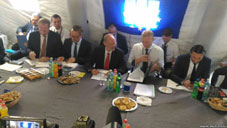
Georgian lands occupation continues
By Gvantsa Gabekhadze
Thursday, July 13
Georgia’s Minister of Reconciliation and Civil Equality, Ketevan Tsikhelashvili, says that Russia’s actions on Georgian soil are not a creeping occupation, but “a very open and dynamic occupation process.”
“The process has been in progress since the Russia-Georgia 2008 war,” Tsikhelashvili said.
“We [the government] are doing our utmost to achieve the removal of all kinds of barriers, banners or barbed-wire-fences on the territory of Georgia, which is a challenge not only for security, but also creates very serious daily problems for locals, many of whom lack access to their own lands,” Tsikhelashvili stated.
The Minister responded to the most recent incident of the creeping occupation, when the occupants moved the occupation line further into Georgian territory in the heart of the country, and stressed this case and similar events would be set out at the meeting in the Ergneti village.
Tsikhelashvili stated the main aim of the Incident Prevention and Response Mechanism Meeting (IPRM) in Ergneti, with the representatives of the occupant forces and de-facto leadership of Tskhinvali (South Ossetia) in attendance, would be solving the existing problems for locals, until achieving strategic goals.
The IPRM meeting, held on July 11, was facilitated by Kestutis Jankauskas, the head of the European Union Monitoring Mission in Georgia (EUMM), and Ambassador Guenther Baechler, the Special Representative of the OSCE Chairperson-in-Office for the South Caucasus.
The meeting provided no genuine outcomes.
A representative of the central Georgian Government, Kakhaber Kemoklidze, said that the de-facto leaders of occupied Tskhinvali think that the only solution to the problem is the demarcation of the "border”.
"This is a trap against the central government and there is no way we are going to be trapped in it,” Kemoklidze said.
Russia recognized the “independence” of the Georgian regions in the wake of the Russia-Georgia war in 2008.


